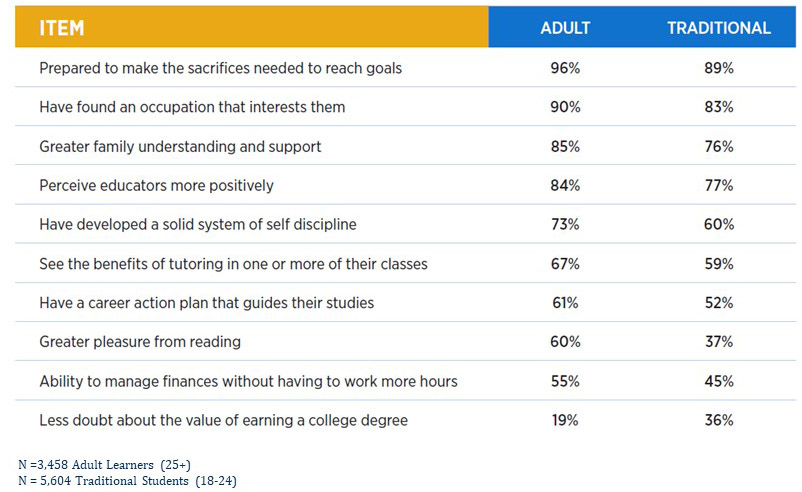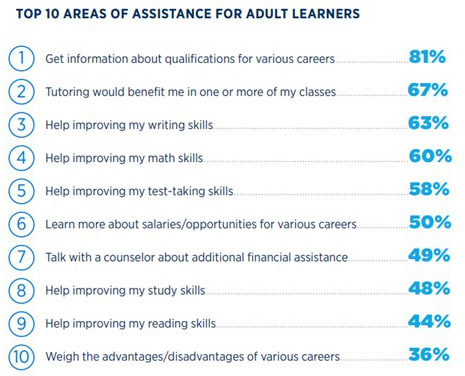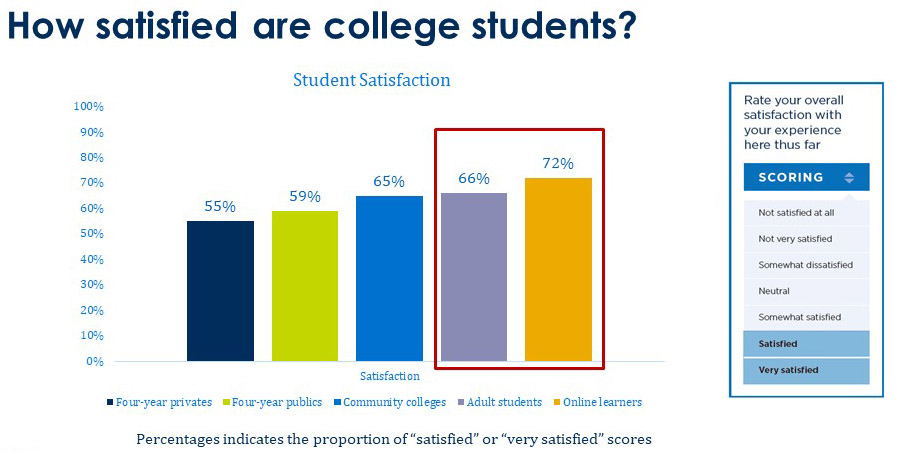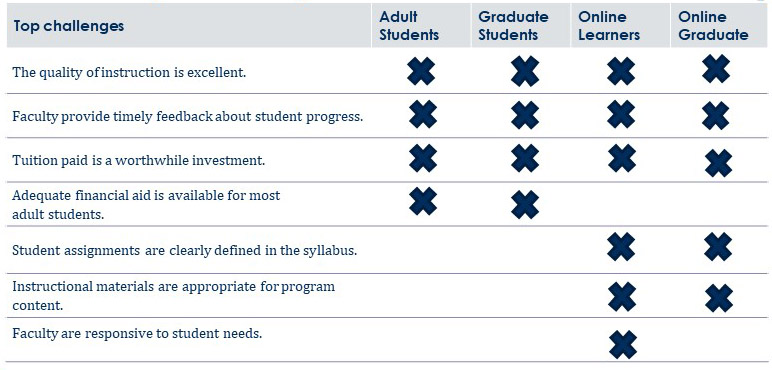enrollment
Student Success Variables for Adult, Graduate, and Online Learners
Adult learners are critical to the future of higher education. With the upcoming “demographic cliff” that almost everyone in higher education is talking about, more institutions are realizing that they need to be prepared to attract and retain adult, graduate, and online learners. As the focus shifts to this expanded market of students, it is important to consider that their needs, their expectations, and their satisfaction levels with the student experience may be very different than the traditional populations that colleges have been used to serving.
Conceptual framework
When it comes to student success and retention, we can think of the following conceptual framework:

Identifying and utilizing the appropriate data in each of these categories will set the institution up to best keep students retained to successfully completing their educational goals. This is true for both your traditional and nontraditional student populations.
Entering Student Variables are the elements that students bring with them when they enroll at your institution. These include their previous course work and grades, how far in advance they applied before the start of the school year, financial aid awards, and other data points that you can often see on an admissions record. These indicators may inform whether they are admitted or not to the institution, but they can also inform the students’ likelihood to be successful and should be monitored from a persistence perspective as well.
Student Motivation Variables are the non-cognitive elements that influence student success. These include academic motivation (study habits, writing and math confidence, commitment to college), general coping skills (social engagement, family support, career plans, financial security), and receptivity to support services from the college (academic assistance, personal counseling, career guidance, etc.). When these data points are gathered from individual students as they enter the institution, they can be used to inform the advising staff on which students are most in need and most receptive to assistance from the college. As featured in the 2021 National First-Year Students and Their Motivation to Complete College Report, this chart compares the level of agreement that adult students and traditional students place on a variety of aspects with their college experience:

These data come from institutions which have administered the College Student Inventory™ with their students, and the results show that adult learners have a strong desire to achieve their educational goals and less doubt about the value of a college degree than traditional students. But that doesn’t mean that these adult learners won’t need support and assistance along the way.
Here are the top areas of desired assistance for adult learners from this same report:

Are you prepared to offer these services to your adult students? Are the services available, accessible, and are your non-traditional students aware of them? These are important considerations to keep in mind.
The key takeaway from this information is that the experiences, life circumstances, resources, and motivation of adult learners give them a different perspective on college than traditional-aged college students. You will want to be sure you have retention strategies and resources that will provide these students with the kind of support they need so more adult learners persist and complete their educational goals.
Student Integration Variables. The last component of this formula are the student integration variables which include elements such as first term grades, class attendance and student satisfaction indicators.
Assessing adult, graduate, and online students to uncover actionable data
RNL offers two satisfaction assessments which gather data from non-traditional populations: the Adult Student Priorities Survey™ which is appropriate for graduate and adult undergraduate students, and the Priorities Survey for Online Learners™ which assesses graduate and undergraduate students in online learning programs. The national data from these two instruments are available to review in the 2021 National Student Satisfaction and Priorities Report. Here are a few highlights from the 41,901 adult students and the 89,261 online learners in the national data sets:

This chart provides a great overview that sets the stage on overall student satisfaction across institution types and student populations. It reflects the percentage of students who indicate they are satisfied or very satisfied with their experience overall. As we see here, online learners show the highest levels of overall satisfaction and adult students (combining graduate and undergraduate responses) are also very satisfied. However, I often say that if nontraditional students are NOT satisfied, they are likely not enrolled because they don’t have time to mess around. They have a lot of competing priorities in their lives and have to make a big commitment to go to school, so the institution needs to meet their expectations for them to stay enrolled. It is important to explore more deeply to understand where there are opportunities to do even better for these students.
The survey instruments from RNL ask students to indicate both a level of importance and a level of satisfaction that they assign to each educational experience. This combination identifies areas of strength (high importance and high satisfaction) as well as areas of challenge (high importance and low satisfaction). The strengths are areas for the institution to celebrate and to use to recruit and attract new students to the institution. The challenges are the priorities for improvement that need to be a core component of any student success efforts to better retain students at the institution. This chart reflects the top challenges that overlap across adult and graduate populations along with online learners and online graduate students, as identified in the 2021 national data sets:

As you can see, the academic experience is key for these nontraditional students, while also being aware of the perception of their tuition dollars being a worthwhile investment. These data point to the opportunity for institutions to intentionally communicate about the academic quality of the programs they offer and to highlight the return on the investment students are making for their futures.
Next steps
As you determine your next steps for improving student success for your non-traditional learners, I encourage you to consider:
- Gathering student motivation and satisfaction data for the populations you serve;
- Identifying areas of strength and challenge from your students’ perceptions to clearly see your opportunities for celebration and for improvement; and
- Developing or incorporating your student-identified challenges into a Strategic Student Success Plan that is in addition to any work you may be doing in this area for the traditional populations you enroll.
Please reach out to us for a complimentary consultation if we can assist you with moving forward to improve the success of your students.
Complimentary consultation on student satisfaction assessment
Talk to our satisfaction assessment experts about how you can easily implement the survey on your campus, including when is the best time to survey and how to get strong completion rates.
